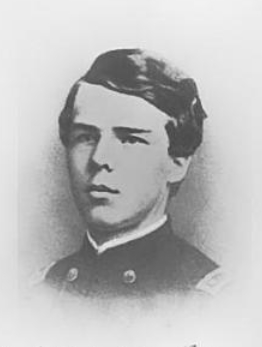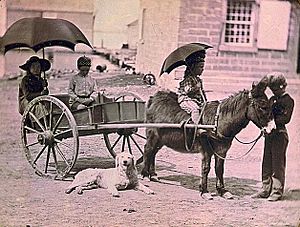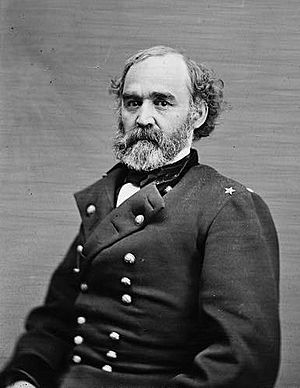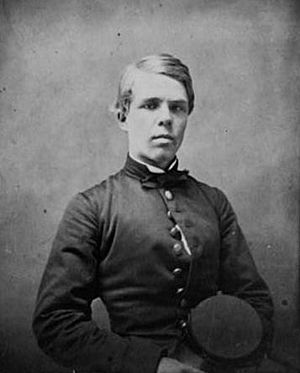John Rodgers Meigs facts for kids
Quick facts for kids
John Rodgers Meigs
|
|
|---|---|

John Rodgers Meigs circa 1864
|
|
| Born | February 9, 1842 Washington, D.C., U.S. |
| Died | October 3, 1864 (aged 22) Swift Run Gap, Virginia, U.S. |
| Place of burial | |
| Allegiance | United States of America Union |
| Service/ |
United States Army Union Army |
| Years of service | 1863-1864 |
| Rank | |
| Battles/wars | American Civil War |
| Relations | Montgomery C. Meigs, father |
John Rodgers Meigs (born February 9, 1842 – died October 3, 1864) was a brave officer in the Union Army during the American Civil War. He was the son of Brigadier General Montgomery C. Meigs, who was in charge of supplies for the U.S. Army.
John Meigs fought in the First Battle of Bull Run. He also went to the United States Military Academy (West Point), where he was a math teacher and graduated at the top of his class in 1863. He was praised for his engineering work, helping to build defenses and map areas for the Union Army. He worked closely with important generals like Phillip Sheridan.
Sadly, John Meigs died during the war. The way he died led to a town called Dayton, Virginia, being burned in revenge. His funeral was a big event, attended by President Abraham Lincoln and other important government leaders.
Contents
Early Life and Education
John Rodgers Meigs was born on February 9, 1842, in Washington, D.C.. His parents were Montgomery C. Meigs and Louisa Rodgers Meigs. He was the oldest of seven children. John was also the grandson of United States Navy Commodore John Rodgers, a hero from the War of 1812.
Because his father was in the military, John's family moved often when he was young. He was mostly taught at home and learned to read and write very early. In 1849, his family returned to Washington, D.C.
In 1856, at just 14 years old, John enrolled at Columbian College in Washington, D.C. He was a very good student, especially in science.
Military Career Begins
Joining West Point
By 1858, John Meigs wanted to join the military like his father. He applied to the United States Military Academy, also known as "West Point." His father, Montgomery Meigs, had to work hard to get him accepted. The Secretary of War at the time, John B. Floyd, initially blocked John's application. However, after his father spoke with President James Buchanan, John finally received an appointment.
John Rodgers Meigs entered West Point on September 7, 1859. His parents often wrote to him, encouraging him to do his best in his studies and military training. He sometimes had trouble with discipline, but he worked hard to improve.
First Battle of Bull Run
The Civil War began on April 12, 1861. Many cadets at West Point wanted to join the fight. John's father, now a brigadier general, was helping to strengthen Union forts. John asked for a break from West Point to help defend Washington, D.C., and his father agreed.
On July 18, 1861, John joined a Union artillery unit. He served as an aide-de-camp, which means he was an assistant who carried orders for Colonel Israel B. Richardson.
On July 21, 1861, John participated in the First Battle of Bull Run. This battle was a big defeat for the Union Army. During the chaos, Meigs helped direct troops when their officers were not present. He later returned home safely and reported to General Winfield Scott, the Union commander.
John received high praise from his commanders. Major Henry Hunt said John "performed his duties with spirit and intelligence." Colonel Richardson called him "a braver and more gallant young man was never in service." Secretary of War Simon Cameron even offered John a promotion, but his father wanted him to finish his studies at West Point first.
Finishing West Point
John's remaining time at West Point went much better. He became a sergeant in the cadet battalion and later an acting assistant professor, teaching math. He graduated first in his class on June 11, 1863. Right after graduating, he became a First Lieutenant of Engineers.
War Service and Death
Early Assignments
After West Point, Meigs worked as an Assistant Engineer. He helped improve defenses around Baltimore, Maryland, Harpers Ferry, West Virginia, and Cumberland, Maryland. This work was important and often dangerous because it was in areas where fighting was happening. Secretary of War Edwin M. Stanton called his service "meritorious and dangerous."
During General Robert E. Lee's retreat after the Battle of Gettysburg in July 1863, Meigs helped keep telegraph lines and roads open for the Union Army.
Working with Generals
In July 1863, Meigs joined the staff of Brigadier General William W. Averell as an engineer and acting aide-de-camp. He created many maps of the area and helped build defensive structures. He also scouted ahead for Averell's troops. He fought in the Battle of Rocky Gap in August 1863 and the Battle of Droop Mountain in November.
Meigs continued to serve with Averell's command. He took part in the "Salem Raid" in December 1863, where Union troops tried to cut off Confederate supply lines by destroying railroad tracks.
The Lynchburg Campaign
In the spring of 1864, Lieutenant General Ulysses S. Grant became the commander of all Union armies. Grant planned a major attack through the Shenandoah Valley in Virginia. Meigs was appointed chief engineer for the Union Army of the Shenandoah.
Meigs fought in the Battle of New Market on May 15, 1864. He also helped repair bridges and scout for the army. He played a key role in the Battle of Piedmont on June 5, where he found a weak spot in the Confederate lines that helped the Union win.
He was with the troops when they took Staunton, Virginia, and helped prevent a fire from spreading through the town. He also helped remove a statue of George Washington from the Virginia Military Institute (VMI) after it was shelled by Union forces.
Meigs continued with the army toward Lynchburg, Virginia. However, during the retreat from Lynchburg, he was not where he was supposed to be when a bridge needed to be built. Because of this, General David Hunter removed him from his position as engineer.
The Valley Campaign
After General Hunter was replaced, Brigadier General Philip Sheridan took command of the army. Sheridan quickly recognized Meigs' skills as a mapmaker. Meigs taught Sheridan about the landscape of the Shenandoah Valley, showing him how the ridges and gaps could be used for surprise attacks.
Meigs became one of Sheridan's favorite officers. On August 17, he was appointed Chief Engineer of the Middle Military Division and an aide-de-camp to General Sheridan.
Meigs fought in the Battle of Opequon on September 19, 1864, which was a big victory for the Union. For his bravery, Sheridan promoted him to brevet Captain. He also fought in the Battle of Fisher's Hill on September 21–22, and was promoted again to brevet Major.
His Death
On October 3, 1864, John Meigs and two assistants were mapping the area around Harrisonburg, Virginia. As they rode at dusk, they met three men in Union uniforms. Believing them to be Union soldiers, Meigs rode closer. However, these men were actually Confederate scouts.
What happened next is unclear, but within moments, Meigs was dead. One of his assistants was captured, and the other escaped to tell General Sheridan. The assistant said Meigs was shot in the back while asking them not to shoot.
Later, one of the Confederate scouts, Frank Shaver, claimed that Meigs fired first after being warned they were Confederates. He said he shot Meigs in the head.
Legacy
The Burning of Dayton
General Sheridan believed Meigs had been murdered. He ordered that Dayton, Virginia, and all houses within five miles of the town be burned. Local people begged them to stop, and Union soldiers helped them save their belongings before setting fires. Sheridan eventually stopped the burning of Dayton, but ordered homes and barns around where Meigs died to be burned instead.
John's father, Montgomery C. Meigs, was heartbroken by his son's death. He believed it was murder and offered a $1,000 reward for the capture of the man he thought was the killer.
Burial and Memorials
Even though many soldiers died in the Civil War, John Rodgers Meigs' death received national attention because his father was a very important general.
John Rodgers Meigs was first buried at Oak Hill Cemetery in Washington, D.C. President Abraham Lincoln, Secretary of War Edwin M. Stanton, and many other important people attended his funeral. Stanton praised him as "One of the youngest and brightest of the military profession."
Later, his father had John's body moved to Arlington National Cemetery. His tomb there has a special bronze sculpture that shows John Rodgers Meigs lying down in his uniform, with marks on the ground as if horses had trampled over him.
A marble column at West Point also lists his name, honoring all graduates who fought for the Union.
In 2006, a book of John Meigs' letters was published, called A Civil War Soldier of Christ and Country: The Selected Correspondence of John Rodgers Meigs, 1859-64.







